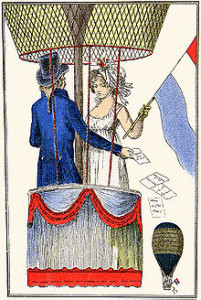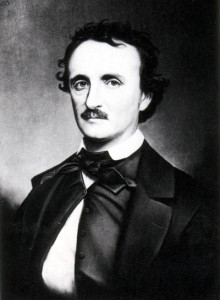I’m always impressed by the inventive Google doodles and I’m venturing into Elena territory today by talking about an event that took place in 1797 on October 22–the first descent by parachute by the daring Andre-Jacques Garnerin in Paris. This was how Google celebrated the event:

 The parachute, more like an umbrella than a modern parachute, was attached to a balloon that, once it had achieved sufficient altitude, M. Garnerin let rip and plummeted to earth from 3,200′. No graceful floating with this prototype parachute. Allegedly he threw up on the enthralled crowd below. Later he adapted his parachute with a vent to make a less exciting descent for both himself and onlookers. You can read a description of the Parc Monceau, the scene of this daring adventure, at Bonjour Paris.
The parachute, more like an umbrella than a modern parachute, was attached to a balloon that, once it had achieved sufficient altitude, M. Garnerin let rip and plummeted to earth from 3,200′. No graceful floating with this prototype parachute. Allegedly he threw up on the enthralled crowd below. Later he adapted his parachute with a vent to make a less exciting descent for both himself and onlookers. You can read a description of the Parc Monceau, the scene of this daring adventure, at Bonjour Paris.
 But it was in the following year that he achieved tremendous notoriety by taking a woman on a balloon ascent. Mon dieu! He had to appear before the Central Bureau of Police to assure them that Citoyenne Henri would suffer no ill effects to her delicate female constitution and that no hanky-panky would take place in the basket. It was eventually decided that a balloon ascent held the same moral danger as sharing a carriage, i.e., not much. Once again a crowd gathered in the Parc to see the first woman in a balloon–ever the showman, Garnerin had wisely chosen a young and pretty woman.
But it was in the following year that he achieved tremendous notoriety by taking a woman on a balloon ascent. Mon dieu! He had to appear before the Central Bureau of Police to assure them that Citoyenne Henri would suffer no ill effects to her delicate female constitution and that no hanky-panky would take place in the basket. It was eventually decided that a balloon ascent held the same moral danger as sharing a carriage, i.e., not much. Once again a crowd gathered in the Parc to see the first woman in a balloon–ever the showman, Garnerin had wisely chosen a young and pretty woman.
His wife Jeanne Genevieve was the first woman to make a parachute descent in 1799 from an altitude of 900 meters. In 1802, during the Peace of Amiens, he and Jeanne Genevieve visited England and made balloon ascents together, and M. Garnerin gave a parachute demonstration in a field near St. Pancras. On another balloon trip he carried a letter of introduction from the Prince Regent in case of a crash landing.
If you’ve ever been in a hot air balloon or parachuted, please tell us about it, and if you wish, report on the effect on your morals and delicate female constitution. And, this has nothing to do with it unless you consider NaNoWriMo the equivalent of diving into thin air: if you’re in or near Maryland, there’s still time to register for Saturday’s workshop Writing From the Ground Up.



